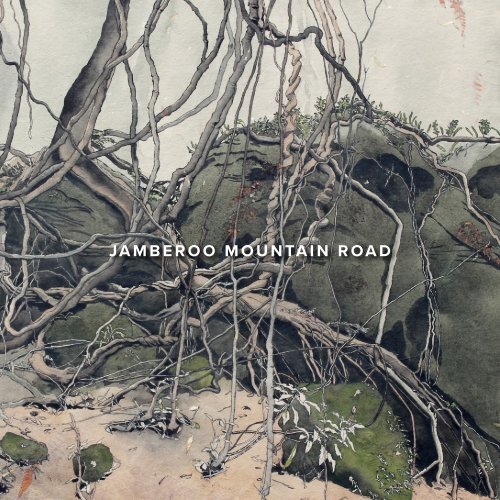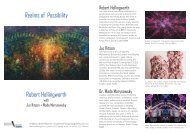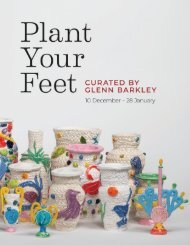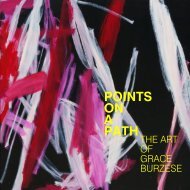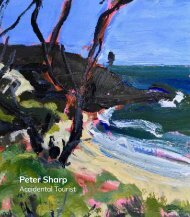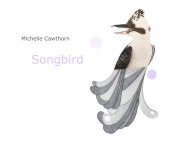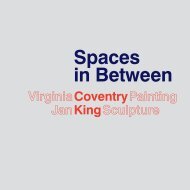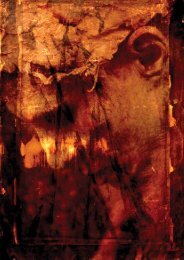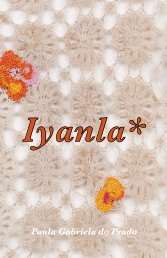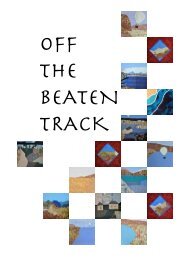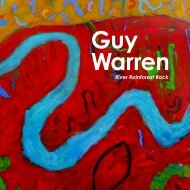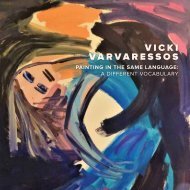Jamberoo Mountain Road
Create successful ePaper yourself
Turn your PDF publications into a flip-book with our unique Google optimized e-Paper software.
JAMBEROO MOUNTAIN ROAD
JAMBEROO MOUNTAIN ROAD
GALLERY INTRODUCTION<br />
BRIDGET MACLEOD AND FIONA MCFADYEN<br />
There is something special<br />
about artist residency projects,<br />
and the exhibition <strong>Jamberoo</strong><br />
<strong>Mountain</strong> <strong>Road</strong> draws on that sense<br />
of excitement, wonder and shared<br />
experience. In the late 1970s artist Guy<br />
Warren and sculptor Bert Flugelman<br />
bought adjoining lots at <strong>Jamberoo</strong><br />
and the landscape provided a rich and<br />
constant source of inspiration from<br />
that point on. Following the death of<br />
Bert, Guy wanted to share the creative<br />
possibilities of “the rainforest, the<br />
mists and the magic of that particular<br />
piece of lush country,” and his new<br />
neighbour, Caroline Lawrence,<br />
generously opened her home for<br />
artists to stay in, continuing the legacy<br />
and extending the history of the<br />
Flugelman property.<br />
When Steve Lopes approached<br />
Shoalhaven Regional Gallery with<br />
information about the residency, the<br />
creation of works and the desire of<br />
the artists involved to exhibit in a<br />
way that told the story of this special<br />
project, we jumped at the opportunity<br />
to display such incredible works of<br />
our local area.<br />
We were lucky enough to visit the<br />
properties in January 2018, when<br />
photographer Riste Andrievski and<br />
artists Michelle Cawthorn, Steve<br />
Lopes, Euan Macleod, Peter Sharp,<br />
Luke Sciberras and Guy Warren were<br />
in residence. Gina Bruce, Ann Cape,<br />
Euan Macleod, Steve by river, <strong>Jamberoo</strong>, 2018, pastel on paper, 28 x 36 cm<br />
Paul Ryan and Ann Thomson had<br />
visited earlier, in late 2017. This was a<br />
fantastic experience as we were able<br />
to witness the artists’ engagement with<br />
the property and each other and be a<br />
part of the creation of the show from<br />
the beginning.
Seeing the way that each artist worked<br />
and what element of the landscape<br />
they chose to focus on was incredibly<br />
insightful. Some artists drew off the<br />
company of others, working in close<br />
proximity, talking and even painting<br />
each other. Other artists chose to<br />
venture further afield, explore on their<br />
own and find a unique area of the<br />
property to depict.<br />
The variety of individual interpretations<br />
is notable and makes for a diverse,<br />
interesting and exciting exhibition.<br />
Some sought out vistas, camping out<br />
on the balcony or climbing high for<br />
long views through to the coast. For<br />
others it was the close detail of the<br />
rainforest that captivated – vines, ferns,<br />
trunks and scrub depicted in lush tones.<br />
Others explored the local fauna– birds<br />
and beetles collected and captured in<br />
collage and charcoal. For Ann Thomson<br />
and Guy Warren, landscapes are<br />
intertwined with memories, impressions<br />
and ideas of place.<br />
This project could not have happened<br />
without the generosity of Guy<br />
Warren and Caroline Lawrence. Both<br />
welcomed us as openly and warmly as<br />
they did the artists, and for this we are<br />
very grateful, thank you.<br />
Thank you also to Steve Lopes for<br />
your wonderful organisational skills<br />
and help throughout the exhibition<br />
and catalogue planning, and to all of<br />
Guy Warren, <strong>Jamberoo</strong>, 1987, ink on paper, 25 x 33 cm<br />
the artists for welcoming us into your<br />
studios to select works and share your<br />
experiences. You were all a joy to<br />
work with and your enthusiasm for the<br />
project was infectious and reflected in<br />
the incredible works produced for this<br />
exhibition.
ESSAY<br />
GUY WARREN am<br />
This exhibition it is not so much<br />
about <strong>Jamberoo</strong> <strong>Mountain</strong><br />
<strong>Road</strong> itself as it is about the<br />
rainforest, the mists, and the magic of<br />
that particular piece of lush country<br />
which clings to the edge of the<br />
escarpment rising at the western end<br />
of the <strong>Jamberoo</strong> Valley. The visitor<br />
is first aware of this after leaving the<br />
fertile greenness of the farmlands<br />
in the valley and driving up the<br />
mountain road between walls of tree<br />
ferns and rainforest. The Illawarra<br />
coast was a source of inspiration for<br />
many of our early artists. Eugene<br />
von Guérard, Conrad Martens, WC<br />
Piguenit, A Henry Fullwood, Arthur<br />
Boyd and Lloyd Rees all come to mind<br />
among the many who have journeyed<br />
south of Sydney to experience and<br />
record their impressions of this<br />
area. I feel certain also that, long<br />
before European artists found it, the<br />
indigenous people must have made<br />
artefacts, records, marks of many<br />
kinds which referenced this particular<br />
country.<br />
One is never alone on those hills, in<br />
the gullies, in the forest. The land<br />
is full of memories, spirits, ghosts—<br />
whichever word suits you. Ghosts of<br />
the original inhabitants, of the early<br />
settlers, of the timber cutters. Walk<br />
through the forest on a dark night and<br />
you’ll meet them.<br />
I understand that in the early days<br />
of European settlement Hoddle, the<br />
government surveyor, together with<br />
a few convicts, established a packhorse<br />
track from the early farms on<br />
the highlands down to the coast<br />
which allowed farmers to get their<br />
produce to the Kiama harbour for<br />
onward movement to Sydney. The<br />
evidence of Hoddle’s Line of <strong>Road</strong> is<br />
still visible today running down the<br />
ridge from <strong>Jamberoo</strong> <strong>Mountain</strong>. To<br />
reach <strong>Jamberoo</strong> <strong>Mountain</strong> today all<br />
one needs to do is to drive up the<br />
<strong>Jamberoo</strong> <strong>Mountain</strong> <strong>Road</strong> or down<br />
from Robertson.<br />
Apart from the odd childhood<br />
memory of once visiting an uncle<br />
who managed the milk factory at<br />
Gerringong, my close association<br />
with the <strong>Jamberoo</strong> area began in the<br />
1970s, when I was working at the Tin<br />
Sheds, an informal art workshop at<br />
the University of Sydney. A friend and<br />
close colleague was the sculptor Bert<br />
Flugelman. We were both looking for<br />
a rural nest somewhere out of the city.<br />
I was seduced by the Hill End area but<br />
decided it was too far out of Sydney.<br />
Bert was looking south around the<br />
Illawarra area and found a block at<br />
the head of the <strong>Jamberoo</strong> valley, half<br />
way up the escarpment. Apparently<br />
a few drinks with the locals in the<br />
pub revealed another available<br />
block next to the one he’d already<br />
been offered. There was no vehicle<br />
access—the tracks established by<br />
the early timber cutters had long<br />
since been eroded and hidden by<br />
rain, fallen timber, massive trees, and<br />
exuberant rainforest. Eventually the<br />
old timber tracks were improved to<br />
the point where they could be used<br />
by a 4WD vehicle. In the meanwhile<br />
the bushwalk into the land was a great<br />
pleasure. Bert bought one block, I<br />
bought another, with neither of us<br />
being quite certain which was whose.<br />
That was decided one day in the<br />
middle of the forest by tossing a coin<br />
to determine who had first choice.
We both ended up happy. Since then<br />
that particular bit of bush has been a<br />
constant source of ideas, imagery and<br />
energy for both of us. For Bert, who<br />
by that time was head of sculpture at<br />
the University of Wollongong, it was<br />
also a permanent and conveniently<br />
situated home.<br />
Bert and his wife Rosemary built a<br />
house on a small ridge in the middle<br />
of the forest. My wife and I together<br />
built a simple shed on our block with<br />
the intention of later building a small<br />
live-in studio nearby capable of being<br />
worked in for short periods. Sadly<br />
this never came about when the local<br />
council announced a ban on any<br />
further building on the escarpment.<br />
Bert and I had often talked of inviting<br />
other artists, even briefly, to share the<br />
creative possibilities offered there.<br />
Sadly again, this didn’t happen until<br />
this year when the present owner<br />
of the Flugelman house, Caroline<br />
Lawrence, herself a sculptor and an<br />
enthusiastic lover of that area, offered<br />
to make her house available for that<br />
purpose. In several groups of four<br />
or five they came, they worked, and<br />
with this exhibition they present the<br />
results of their vision and reaction<br />
to the rainforest escarpment.<br />
While my own works are inevitably<br />
influenced by 40-odd years of close<br />
association with the land and with<br />
memories, many of these artists had<br />
not previously experienced this kind<br />
of country. Despite the long and<br />
still thriving tradition of landscape<br />
painting in Australia there is not a<br />
long history of artists working with<br />
the rainforest, with a few notable<br />
exceptions. The romance of the red<br />
heart and the gumtree have seduced<br />
the majority of artists and sent them<br />
inland or to the coast. Maybe they<br />
found it difficult to cope with leeches.<br />
This indeed might be the first time<br />
that a disparate group of artists have<br />
set out deliberately to capture what<br />
they see as the essence of this area.<br />
Now in this exhibition a group of<br />
artists of different ages and interests<br />
and backgrounds, having wound<br />
their way through the tree ferns of<br />
the <strong>Jamberoo</strong> <strong>Mountain</strong> <strong>Road</strong> (or<br />
reached it via Robertson), offer their<br />
reactions to this very beautiful part of<br />
the very beautiful Illawarra coast. A<br />
vote of thanks must be given to all the<br />
artists for their contributions, to Steve<br />
Lopes for his help and organisational<br />
skills and to the Shoalhaven Regional<br />
Gallery for offering to mount the<br />
exhibition. And a very special thunder<br />
of thanks should be given to Caroline<br />
Lawrence for her generous help with<br />
accommodation and her warm and<br />
enthusiastic co-operation.<br />
April 2018
RISTE ANDRIEVSKI<br />
A<br />
reconnection from 20 years<br />
past. As an art student we<br />
visited Guy Warrens and Bert<br />
Flugelman’s property as an art project<br />
to inspire us with our future art. 20<br />
Years later having the opportunity to<br />
revisit and reinvigorate the creative<br />
spirit. It was an inspiring opportunity<br />
to have that creative energy<br />
surrounded by artists that drew<br />
from an environment and land that<br />
provided a creative feed for artists.<br />
Photographing each artist that I met<br />
at the property was to document the<br />
process and energy that was present.<br />
Robert Malherbe, Riste, 2017, ink on paper
GINA BRUCE<br />
Painting outside in the landscape<br />
involves managing the elements<br />
as well as the painting process.<br />
The sudden gust of wind, or an<br />
approaching storm, and the race<br />
against the fading light, adds to the<br />
excitement. The moving clouds are<br />
so beautiful, but you have to be quick<br />
to capture them; the subject you are<br />
looking at is forever changing.<br />
Working alongside other artists on<br />
this <strong>Jamberoo</strong> <strong>Mountain</strong> <strong>Road</strong> project,<br />
was a great experience.<br />
I had never met many of the other<br />
artists before. I found the whole<br />
group to be inspiring in their stamina,<br />
work ethic, and generous spirit;<br />
both genders, across a broad age<br />
range from 39 - 95 years old. The<br />
conversations at mealtimes, enhanced<br />
by sketching each other, was lively.<br />
The hospitality of Caroline, the owner<br />
of the property was so generous.<br />
Walking through the forest, Caroline<br />
introduced me to the wide variety of<br />
fungi that she explained holds the<br />
whole rainforest eco-system together.<br />
The rainforest reminded me of up<br />
near Minyon Falls in the Northern<br />
Rivers area NSW where I lived for a<br />
while. The colours, smells, sounds,<br />
light, filling all your senses. One<br />
morning I enjoyed working up at Guys<br />
studio, a higher vantage point looking<br />
out and down into the valley through<br />
the trees.<br />
I started with drawings in my<br />
sketchbook, then moved to<br />
watercolours on paper, looking to<br />
capture the light, the colours, the<br />
space and feeling of this special<br />
place. I then moved to acrylic on<br />
pieces of cut polyester, then to<br />
larger boards. The 2 larger boards<br />
I continued on back at home in my<br />
studio.<br />
I would like to thank; Guy Warren and<br />
Steve Lopes for including me in this<br />
project, Caroline Lawrence for hosting<br />
me at her house, and the Shoalhaven<br />
Regional Gallery for their efforts in<br />
curating this exhibition. It was such<br />
a great pleasure and honour to work<br />
with all the artists on this project.
Green-Grey-Blue, watercolour, 50 x 34 cm<br />
Green Light, acrylic on polyester, 60 x 27 cm
Rainforest-tree-cloud, acrylic on board, 150 x 60 cm<br />
Tree-trunks and hut, watercolour, 50 x 17 cm
ANN CAPE<br />
When I visited <strong>Jamberoo</strong> it<br />
was in autumn, the weather<br />
was mild, but the rain<br />
continuous. We were mostly confined<br />
to painting from Caroline’s house on<br />
the vast veranda surrounding the<br />
structure created by Bert Flugelman.<br />
I was confronted by a wall of verdant<br />
green, looking down the steep slope<br />
to the valley and the base of massive<br />
trees that towered up above us. Mist<br />
clung to the hillsides and wafted past<br />
a hardly discernible distant view of the<br />
ocean and coastal plain below.<br />
This was an unfamiliar landscape for<br />
me, having mostly worked with an<br />
earthy palette of open spaces, or with<br />
the figure. This was up close, dense<br />
and textured with lots of leeches!
<strong>Mountain</strong> in the morning mist, 2018, oil on linen, 76 x 76 cm
From the verandah in the rain 1, 2018, oil on canvas, 76 x 76 cm<br />
Into the rainforest, 2018, oil on canvas, 76 x 76 cm<br />
Guy in his shed, <strong>Jamberoo</strong>, 2018, oil on canvas, 76 x 76 cm<br />
From the verandah in the rain 2, 2018, Oil on Canvas, 76 x 76 cm
MICHELLE CAWTHORN<br />
CAROLINE’S BIRDS<br />
When I was 10, my parents<br />
moved us from Sydney’s<br />
Sutherland Shire to Nowra<br />
on the South Coast of NSW. We<br />
lived in Cambewarra where we were<br />
skirted by the Shoalhaven River to<br />
one side and Cambewarra <strong>Mountain</strong><br />
on the other. I travelled over this<br />
mountain each day to attend high<br />
school, winding up and down through<br />
rainforest undergrowth.<br />
Sometime before we made our way to<br />
our host Caroline Lawrence’s home on<br />
<strong>Jamberoo</strong> <strong>Mountain</strong> for this project, I<br />
began to consider the approach that<br />
I would take when responding to the<br />
landscape, a place I suspected might<br />
seem very familiar to me because of<br />
my childhood experience, and yet not.<br />
My practice is concerned with memory<br />
and how it might be expressed visually,<br />
so my first thought was drawing. I<br />
reminisced on the experience of<br />
being in the bush and rainforest, which<br />
always echoed with bird song, and I<br />
decided that birds should somehow<br />
feature in my response.<br />
As serendipity would have it,<br />
when I was discussing my ideas<br />
with Caroline and enquiring as to<br />
whether she had any information<br />
on the birds in her locale, she<br />
pointed me towards her library<br />
where there were a number of<br />
relevant books. Tucked away on<br />
one of her shelves was a beautiful<br />
set of cloth bound books titled, ‘A<br />
History of British Birds’ by Rev F O<br />
Morris, published sometime in the<br />
1850’s or 1860’s. Caroline was born<br />
and raised in England and settled<br />
in Australia in her late 20’s. When<br />
her father passed she inherited the<br />
entire 8 volumes, each filled with<br />
detailed engravings of the birds<br />
of her homeland. Immediately I<br />
knew I had my project. I decided<br />
to weave Caroline into the history<br />
of the former property of the late<br />
Bert Flugelman, a place she now<br />
considers herself ‘caretaker’ of; and<br />
combine her birds with Australian<br />
birds, both those found in the area<br />
and ones she may have encountered<br />
on her travels around Australia.<br />
I asked Caroline to go through all 8<br />
volumes and to choose 20 images<br />
that she particularly remembered from<br />
her childhood. I combined those with<br />
watercolour images of Australian birds<br />
that I had collected over time. The<br />
result is Caroline’s Birds.
Caroline’s Birds (1), 2018, watercolour and collage on Hahnemühle paper, 34 x 34 cm
Caroline’s Birds (2), 2018, watercolour and collage<br />
on Hahnemühle paper, 30 x 25.5 cm<br />
Caroline’s Birds (4), 2018, Watercolour and collage on Hahnemühle paper, 21 x 15 cm<br />
Caroline’s Birds (5), 2018, watercolour, collage and acrylic<br />
on Hahnemühle paper, 36 x 35.5 cm
STEVE LOPES<br />
<strong>Jamberoo</strong> is such a unique place<br />
for an artist. At first glance it can<br />
seem visually inhibiting with such<br />
an envelopment of trees. On closer<br />
inspection and investigation, I came<br />
away with a real excitement about the<br />
area and a better understanding of<br />
the rainforest and its hidden beauty.<br />
On my first painting trip there, 5<br />
days of pouring rain wasn’t enough<br />
to dampen our creative energies, in<br />
fact we were all hemmed in painting<br />
together and had to really search<br />
hard to make good pictures. This<br />
allowed us to analyse the depth of<br />
colours and points of interest in the<br />
surrounding rainforest at a slow pace.<br />
On my second trip it was completely<br />
different with days of sunshine<br />
and the chance to really explore<br />
outdoors and paint the prehistoric<br />
plant life, and unfamiliar precious<br />
landscape that one can easily take<br />
for granted. It felt special to be in that<br />
undergrowth, painting with friends,<br />
especially amongst the hospitality of<br />
its caretakers Caroline Lawrence and<br />
Guy Warren.
Creek Bed Study, 2018, oil on canvas, 90 x 90cm
Undergrowth Study, 2018, oil on board, 50 x 90cm<br />
Coast View and Rainforest, oil on board, 45 x 45cm<br />
Rainforest Study - afternoon south view, 2017, oil on board 50 x 50 cm
EUAN MACLEOD<br />
Landscape artists seem to be<br />
attracted to a certain type of<br />
landscape. Possibly it reflects<br />
something of their inner world,<br />
or maybe they love the visual<br />
possibilities. When I think of Guy’s<br />
work I think of rainforest and his<br />
mastery of an environment I would<br />
find the hardest to try and paint. I<br />
love the bare hills that expose their<br />
structure. I find vegetation hides what<br />
it is that I love to paint.<br />
Guy has talked about his shack in the<br />
<strong>Jamberoo</strong> bush for ages and about<br />
getting people up to the place that<br />
has meant so much to him for so long.<br />
I see this sharing of your ‘special<br />
place’ as an incredibly generous act<br />
and the camaraderie is what attracted<br />
me to be one of the artists involved,<br />
rather than the actual landscape.<br />
It’s always fascinating to see how<br />
different people respond to the same<br />
place - what they bring, and what they<br />
take away.<br />
Thank you Guy and also thank you to<br />
Caroline who put us all up and was<br />
so hospitable when we were there.
<strong>Jamberoo</strong> <strong>Mountain</strong> <strong>Road</strong> Study, 2018,<br />
oil on polyester, 38 x 51 cm<br />
<strong>Jamberoo</strong> Bush (with rock), 2018, oil on<br />
polyester, 53 x 66 cm<br />
Steve Painting, <strong>Jamberoo</strong> (with red hat),<br />
2018, oil on polyester, 53 x 66 cm
<strong>Jamberoo</strong> <strong>Mountain</strong> <strong>Road</strong>, 2018, oil on polyester, 53 x 66 cm
ROBERT MALHERBE<br />
“ Mind the leeches.” This was<br />
one of the first things said<br />
to me by Master printer Tom<br />
Goulder as we drove into Caroline<br />
Lawrence’s property built within a<br />
beautiful rain forest in <strong>Jamberoo</strong>.<br />
I was to stay there for four days to<br />
paint in the open air with fellow artists<br />
Guy Warren, Steve Lopes, Gina Bruce,<br />
Anne Cape, Ann Thompson and Paul<br />
Ryan to name a few. Unfortunately<br />
it rained most of the four days and I<br />
had to do my best with painting still<br />
lives and when the clouds eventually<br />
broke the magnificent view from<br />
the veranda. I became somewhat<br />
obsessed with the view from the<br />
veranda and feel I could still paint it<br />
over and over again.<br />
I have fond memories of Caroline’s<br />
elegance and generous hospitality,<br />
her wonderful dinners and delicious<br />
coffees. Not to mention Guy Warren’s<br />
dinner table wit and art world banter<br />
that kept us all entertained.
Untitled 3, 2017, mixed<br />
media on card, 28 x 21.5 cm<br />
Untitled 4, 2017, mixed media<br />
on card, 28 x 21.5 cm<br />
<strong>Jamberoo</strong> Landscape 2, 2017, oil on board, 50 x 40 cm
<strong>Jamberoo</strong> Landscape 4, 2017, oil on linen, 61 x 51 cm<br />
<strong>Jamberoo</strong> Landscape 3, 2017, oil on board, 50 x 40 cm
MAX MILLER<br />
themselves - even rocks, trees and<br />
all things.<br />
I was told in an art lecture, long ago,<br />
that glass is a liquid and moves slowly<br />
as do all things, even earth and rocks<br />
are always changing.<br />
Nothing is more moving than to camp<br />
under the stars and watch trees<br />
moving. Hear the activity of night<br />
noises and observe the Milky Way and<br />
see shooting stars etc.<br />
One has to have a respect for all life<br />
forms.<br />
Max Miller 2009<br />
I<br />
love the detail of the microcosm<br />
and its intrinsic relationship with the<br />
universe and life’s spirituality therein.<br />
Also its relationship to human kind,<br />
which I consider is no more important<br />
than life forms around it.<br />
The aboriginal people understand<br />
everything as having life and spirit,<br />
in as far as seeing themselves<br />
related as totems and dreamings of<br />
While Max Miller attended the 2017<br />
residency, the works included in <strong>Jamberoo</strong><br />
<strong>Mountain</strong> <strong>Road</strong> were produced between<br />
1993 and 2013. Miller has lived in the<br />
Southern Highlands and had a close<br />
relationship with the surrounding rainforest<br />
for a number of years. He has always been<br />
drawn to more intimate subjects, and while<br />
in the highlands tended to shy away from<br />
vistas and views and gravitate to the local<br />
rainforest, where he would often sit all day<br />
painting under the trees.
Native Figtree and Vines, 1993, watercolour on handmade paper, 51 x 66 cm<br />
Kangaroo Valley Escarpment, 1987, egg tempera on linen, 51 x 36.5 cm
Rainforest - Untitled, 1987, egg tempera on linen, 46.5 x 36 cm<br />
Landscape of special Environment of Significance - Southern Highlands, 2013, Diptych - watercolour on handmade paper, 61 x 103 cm
LUKE SCIBERRAS<br />
There are some studios in<br />
Australia that are unique in<br />
their genius loci - the spirit of<br />
place. The eyries perched on the<br />
escarpments of <strong>Jamberoo</strong> are two of<br />
them. Two studios constructed within<br />
a stones throw of each other, tended<br />
by kindred spirits and devotees of<br />
nature have held a magnetism for<br />
decades. An environment in which<br />
countless artworks, quiet thoughts<br />
and raucous dinners have floated<br />
through the trunks and vines.<br />
Perched between the footsteps of the<br />
southern highlands and the hinterland<br />
of the NSW south coast, <strong>Jamberoo</strong> is<br />
a floating, twisting, growing, decaying<br />
rainforest teaming with life. It seems<br />
to grow and crumble before ones<br />
very eyes, all the while the massive<br />
old growth tree trunks frame views<br />
glimpsed to the sparkling ocean in<br />
the hazy distance. It is no wonder that<br />
Guy Warren has been drawn to dream<br />
this place up in his own songlines for<br />
so many decades.<br />
The camaraderie among friends there<br />
now spans generations and crafts,<br />
and is bound by a shared love of the<br />
natural environment and a tremendous<br />
respect for each other’s work.
Along the jungle floor, <strong>Jamberoo</strong>, 2018, oil on board, 120 x 160 cm
Jungle boulder, <strong>Jamberoo</strong>, 2018, oil on board, 120 x 160 cm<br />
The competition for sunlight , <strong>Jamberoo</strong>, 2018, oil on board, 120 x 160 cm
PAUL RYAN<br />
In 1987 I commenced the Bachelor<br />
of Creative Arts at Wollongong<br />
University. My painting teacher was<br />
Bert Flugelman and meeting him was<br />
my first encounter with a professional<br />
practicing artist.<br />
Burt employed me and another<br />
student to work on his property in the<br />
rainforest on <strong>Jamberoo</strong> <strong>Mountain</strong>. He<br />
was in the process of building his new<br />
house and studio on site. We cut logs,<br />
dug holes and built a no dig veggie<br />
garden. I felt like a pioneer. A settler.<br />
Going back to the site more than<br />
thirty years later brought back<br />
vivid memories. This time I had the<br />
pleasure of meeting the new owner<br />
of the property and all the artists who<br />
had come to make works there.<br />
In the first week an east coast low<br />
descended on the coast. When I<br />
arrived in the morning there was<br />
brilliant sunshine and a few clouds<br />
building from the south. Within a few<br />
hours the rain was pelting down and<br />
did so for days.<br />
I managed to do a couple of small<br />
paint sketches. Months later I made<br />
the big painting in my studio. I painted<br />
it from memory. It is large dark and<br />
green with a muddy bush road<br />
winding out of the forest. It is painted<br />
with big brushes in crude raw brush<br />
strokes, more a painting of a memory<br />
of the place than an actual section of<br />
road.
The <strong>Road</strong> to Berts, 2018, oil on linen, 280 x 220 cm
<strong>Jamberoo</strong> <strong>Mountain</strong> Study, 2017, oil on linen, 81 x 71 cm
PETER SHARP<br />
I<br />
was lucky enough to have been<br />
taught by Guy Warren in 1987 at City<br />
Art Institute which is now the Faculty<br />
of Art and Design at UNSW, where I<br />
now teach.<br />
Guy was wonderful in that he didn’t<br />
tell me what to do but talked about<br />
life as an artist and what a wonderful<br />
example he still is.<br />
I was thrilled to be invited to the<br />
‘<strong>Jamberoo</strong>’ property that he shared<br />
with Bert Flugelman and spend time<br />
with him immersed in that rainforest<br />
escarpment.<br />
I just drew everything without any<br />
preconceptions and then made<br />
paintings from the fern drawings as if<br />
they were open ended plans.<br />
The paintings often end up abstracted<br />
but they come from real observation<br />
and recognition that is central to my<br />
practice.<br />
The drawings are never wasted as<br />
they end up as a visual catalogue of<br />
where I have been and the details that<br />
I have seen and this I believe gives<br />
a poetic summation of that specific<br />
rainforest area.
Fern Painting 3, oil and acrylic on<br />
linen board, 46 x 35 cm<br />
Fern Painting 2, oil and acrylic on<br />
linen board, 46 x 35 cm<br />
Fern Painting 1, oil and acrylic on linen board, 46 x 35 cm
Installation view of 48 rainforest drawings, charcoal on A4 and A5 paper
ANN THOMSON<br />
Filled with his drawings and works<br />
on paper, Guy Warren’s hut in the<br />
<strong>Jamberoo</strong> Rainforest is a living,<br />
moving thing, just as the vines fungi<br />
and leeches of the forest are moving<br />
around it.<br />
What a privilege for we artists to be<br />
invited there to paint and pay homage<br />
to Guy and his landscape.<br />
When I was there it rained and<br />
it rained. I loved working with<br />
water based paints in that watery<br />
atmosphere.
Water and Air Series Vase 2018, painting on on ceramic vase, 17 x 15 x 15 cm<br />
Water and Air Series Bowl 2018, painting<br />
on on ceramic bowl, 10 x 21.5 x 21.5 cm<br />
Rainforest II, 2017, acrylic on canvas, 56 x 71 cm<br />
Rainforest III, 2017, acrylic on canvas, 76 x 76 cm
GUY WARREN<br />
The paintings of mine in this<br />
exhibition all have their<br />
genesis in my long association<br />
with <strong>Jamberoo</strong> <strong>Mountain</strong> and the<br />
rainforest, and in particular with that<br />
small parcel of land which I own and<br />
on which my late wife and I built a<br />
small shed 40 years ago. On the<br />
eastern side of all the ridges and<br />
gullies of the escarpment which<br />
runs down the Illawarra coast, the<br />
clouds which roll in from the ocean<br />
are captured by the escarpment,<br />
drop as rain and form a perfect<br />
environment for rainforest. I happen<br />
to love rainforest -- I fell in love with<br />
it many years ago in Queensland<br />
and in New Guinea during the war.<br />
<strong>Mountain</strong>s and rainforest have<br />
fascinated me ever since. I also have<br />
childhood memories of uncles who<br />
lived in Gerringong and Austinmer<br />
and of surfing with my brother at<br />
Austinmer and of a crazy journey by<br />
canoe down the Shoalhaven River<br />
from near Goulburn to the coast at<br />
Nowra almost eighty years ago. And<br />
of course fond memories of working<br />
for several years with the University<br />
of Wollongong. So it does seem that<br />
the Illawarra Coast satisfies all my<br />
fantasies. These works of mine are<br />
about the shed (the so-called hut on<br />
the hill) and the memories and the<br />
fantasies and the good times.
Through the Mist to the Hut on the Hill, mixed media on canvas, 90 x 122 cm
Along the Track in the Mist, 2018, oil on acrylic on canvas, 90 x 120 cm
Hut on the Hill, with Memories, 2018, acrylic on canvas, 91 x 122 cm
ACKNOWLEDGMENTS<br />
<strong>Jamberoo</strong> <strong>Mountain</strong> <strong>Road</strong> was exhibited at Shoalhaven Regional Gallery Nowra from June 9 – August 4 2018.<br />
SRGN would like to thank the artists’<br />
representing galleries<br />
Art Atrium – Max Miller<br />
Defiance Gallery – Ann Thomson<br />
King Street Gallery on William –<br />
Guy Warren, Luke Sciberras<br />
Liverpool Street Gallery – Peter Sharp<br />
Michael Reid Gallery –<br />
Robert Malherbe<br />
.M Contemporary – Michelle Cawthorn<br />
Nanda\Hobbs – Paul Ryan<br />
Robin Gibson Gallery – Gina Bruce<br />
Stella Downer Fine Art – Steve Lopes<br />
Watters Gallery – Euan Macleod<br />
All images c. the artists<br />
Artwork Photography by<br />
Michel Brouet<br />
Sophie Cape<br />
Colin Husband<br />
Dana Rayson<br />
Peter Solness<br />
Tony Lopes<br />
Portrait Photography by<br />
Riste Andrevski<br />
Peter Sharp<br />
Michelle Cawthorn<br />
Design<br />
Kim Gregory<br />
Printing<br />
Hero Print<br />
Cover image Max Miller, Native Figtree<br />
and Vines, 1993, watercolour on<br />
handmade paper, 51 x 66 cm<br />
Shoalhaven Regional Gallery Nowra<br />
12 Berry Street, Nowra<br />
02 4429 5443<br />
www.shoalhavenregionalgallery.com.au<br />
ISBN 978-0-6483014-1-7
Featuring<br />
RISTE ANDRIEVSKI<br />
GINA BRUCE<br />
ANN CAPE<br />
MICHELLE CAWTHORN<br />
STEVE LOPES<br />
EUAN MACLEOD<br />
ROBERT MALHERBE<br />
MAX MILLER<br />
PAUL RYAN<br />
LUKE SCIBERRAS<br />
PETER SHARP<br />
ANN THOMSON<br />
GUY WARREN<br />
ISBN 978-0-6483014-1-7


